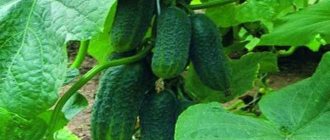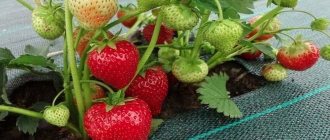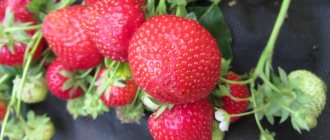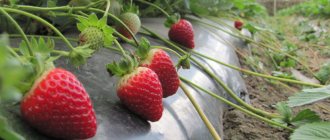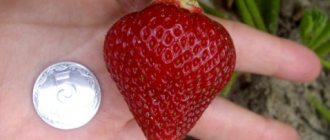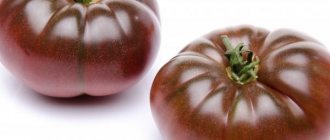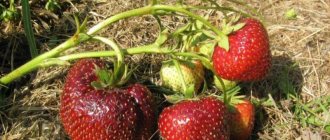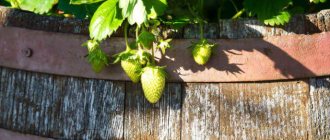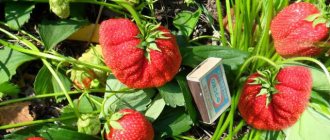Main characteristics
The culture is classified as an ultra-early variety. The bushes are small, have leaves with fluff and slight corrugation. The peduncles are directed upward, are quite strong and can easily support the weight of the fruit. Each peduncle can have up to 20 buds. Reproduction occurs through whiskers, of which there are always a lot.
In open ground conditions, the plant can cope with frosts down to -35 degrees, if there is enough snow in the garden bed. If winter is not characterized by a lot of snow, then the roots die out at a temperature of -8 degrees.
Disease resistance is good, and strawberries can grow even in not the best conditions. Copes with short-term drought, is not afraid of rotting and many diseases.
Fruiting occurs already in the first year after planting. In the garden beds, the crop is ready for harvest in mid-to-late May, and in the greenhouse – even earlier.
Characteristics of berries and photos
This variety is characterized by tall, compact bushes. Its bright green, pubescent foliage has erect, petioles about 10 centimeters long. Its powerful, hard peduncles rise upward, and more than twenty buds are formed on them. And even after a large number of berries ripen, they do not fall to the ground. The fruits have a rather attractive appearance and high taste.
The main characteristics of the variety include the following:
- dark red shiny surface;
- absence of a cavity inside the fetus;
- comb-shaped;
- weight from 20 to 60 grams;
- harvest weight up to 1 kilogram from each bush;
- dense but tender pinkish flesh with white veins;
- rich sweet taste;
- pronounced strawberry aroma.
Description of fruits
Zephyr fruits are quite large. The berries are painted bright red and have a shiny surface. The fruit stem is strong. The shape of the strawberry is blunt-conical or comb-shaped, somewhat ribbed. The pulp has a delicate pink tint, there are no voids. As for taste, tasters give it high marks. Strawberries have a pleasant juicy structure, moderately sweet, and the smell is very rich.
Fruits are characterized by one-dimensionality. That is, at the end of the season they do not become smaller.
The usual weight of strawberries is 20 grams, but fruits often weigh 60 grams. The product characteristics are very good, the fruits can be stored without problems. You can eat it both fresh and processed. Zephyr strawberries make excellent frozen products. True, it is not suitable for jam.
Strawberry Zephyr: description of the berry variety
Zephyr strawberries are not remontant, so the crop is harvested from the bushes once a season. Fruit ripening is smooth, the first ripe berries appear in the last days of May.
The bushes of this strawberry are tall, neat, the foliage is medium in size, slightly corrugated, soft emerald color, with long erect petioles (up to 8-10 cm in length). The strawberry bush produces a large number of strong, powerful flower stalks, each of which can ripen up to 17-20 berries. The peduncles do not bend under the weight of ripening fruits, so the fruits remain clean.
Important!
Strawberry bushes of the Zephyr variety produce a sufficient number of tendrils, so farmers do not have problems with the propagation of these strawberries.
The fruits are crimson colored, shiny, firmly held on strong stalks, without dripping even after full ripening. The shape of the fruit is blunt-conical, can be ribbed or with scallops. The pulp is quite dense, without voids, pale pink in color with thin white veins. The taste of the fruits of the Zephyr variety is juicy, sweet, the aroma is typically strawberry. The weight of ripe berries is 25-35 g, but the first berries can weigh up to 55-60 g.
Therefore, Zephyr strawberries are a large-fruited berry crop.
Fruits in appropriate containers withstand the transportation process well over any distance, while the berries do not wrinkle and do not produce juice.
Interesting!
Since the Zephyr strawberry variety is an early ripening variety, many gardeners grow it for subsequent sale. But the harvested crop can be consumed fresh, for making preserves, jams, compotes, and also frozen for the winter.
It is not recommended to propagate this variety by seeds, since the resulting plants most often do not retain their parental characteristics.
Therefore, the easiest and simplest ways to propagate Zephyr strawberries is by dividing bushes and mustaches. It is recommended to grow this strawberry in one place for no more than 4-5 seasons, as the fruits begin to become smaller, resulting in a decrease in yield.
Productivity
With proper garden care, you can get up to a kilogram of berries from one bush. It is important to note that good fruiting continues for four years, then the crop will have to be replanted, for which the tendrils are pulled aside and the formed rosettes are rooted. You can expect good yield indicators already in the first year after planting.
Harvesting is preferably done in the morning or evening. The fruits are transported in plastic containers and stored in the refrigerator.
Reproduction
Strawberries of the Zephyr variety can grow in one bed for up to four years. After this, it is necessary to transplant the plants to another location. At the same time, you can increase the area of the beds.
More on the topic: Malvina strawberries
The most effective way to propagate the Zephyr variety is by rooting the mustache. The mustache is chosen from the first or second row, the rest are cut off. By the way, a large number of mustaches in this variety is considered one of the main disadvantages.
You can also use seeds or dividing bushes for propagation, but this reduces the yield and the properties of the mother plant are lost.
Diseases and pests
In general, Zephyr is not afraid of most diseases typical for garden strawberries. It is advisable to carry out the treatment using a solution prepared from 2-3 tablespoons of copper sulfate diluted with a bucket of water. This will increase the individual’s immunity and improve its resistance to diseases.
Alas, sometimes the variety suffers from gray mold. This problem spreads throughout the bush. The most affected are the berries, which become very soft and covered with a gray coating. Fundazol, Topsin M, Euparen are used for treatment. Treatment activities begin in early April and are carried out about 4 times, maintaining an interval of a week and a half.
If we talk about parasites, Zephyr is most afraid of the strawberry mite. It often begins its activity at high humidity. Typically, the tick prefers the young foliage of the plant, feeding on the juices. The leaves begin to shrink and turn yellow. Later they die off.
To get rid of the pest, it is recommended to get rid of any plant debris around the strawberries in autumn and spring. When you plan to plant a young individual, you need to treat them: dip them, roots up, in a solution of karbofos at the rate of 75 grams per bucket of water. Also in spring, the use of Karate or Arrivo preparations is allowed. In the summer, when the mustache is formed, they recommend Mitak, Omite. In autumn - Isofen.
Advantages and disadvantages
Before placing a crop on his site, any gardener should carefully study the advantages and disadvantages of the plant. Let's consider the pros and cons of the Zephyr variety.
Advantages
- Good ripening time both in the beds and in the greenhouse. When grown under film, you can get fruits as early as May.
- The plant has a long fruiting period.
- The yield is not bad.
- The seedlings adapt to environmental conditions without problems, and begin to bear fruit after a year.
- Zephyr is a commercial variety that sells well and is not afraid of transportation.
- In the presence of snow, the plant can withstand frosts down to -35 degrees.
- Can tolerate short droughts.
- It has excellent immunity to most diseases and pests.
Flaws
- Afraid of mold and mites.
- Towards the end of fruiting, the crop may become smaller.
- Does not survive in cold weather unless there is good snow cover.
- For some gardeners, the downside may be that the plant requires pollination.
- Strawberries form a lot of whiskers.
Positive and negative qualities of Zephyr
This variety has a huge number of advantages, which is why it is valued by European gardeners. Among the main advantages of Zephyr it is worth highlighting:
- Very early harvest ripening.
- Friendly formation of the harvest. This is a huge plus for the industrial cultivation of strawberries, as harvesting is greatly simplified.
- Zephyr is a fairly frost-resistant variety. It winters well in regions with unfavorable climates.
- It has fairly good drought resistance.
- Zephyr is easy to care for. Even an inexperienced gardener can grow strawberries of this variety.
- It is not particularly picky about the type of soil in which it will be grown.
- The berries have high commercial quality. Strawberries are beautiful to look at, tolerate transportation well and have high shelf life.
- Marshmallow has excellent immunity. From 2002 to 2006, specialists from the Federal State Budgetary Institution “All-Russian Selection and Technological Institute of Horticulture and Nursery Growing” conducted tests, as a result of which it was possible to find out that the Zephyr variety is one of the most resistant to diseases such as powdery mildew and brown spot.
However, it is worth noting a number of disadvantages of this variety. These include:
- Marshmallow forms a fairly large number of whiskers. On the one hand, this is a plus, since the plantings are easy to propagate, but on the other hand, it significantly complicates caring for strawberries.
- The plant is not resistant to the strawberry mite.
Landing
Before planting, you should decide on the location of the plant. Zephyr loves lighted places with slight partial shade. It is advisable that the site be protected from the wind. The crop is not picky about the soil, but it is advisable to place it in soil with neutral acidity. It feels great if you plant it where carrots, cabbage or zucchini used to grow.
If it is necessary to place seedlings, then planting activities are carried out in April or at the end of summer. But an adult can be moved to a new place in October. Experienced gardeners advise selecting already shortened young bushes with a small number of leaves. It is advisable that they be sold in separate containers. This will allow the individuals to be transplanted through transshipment, which is the safest for them.
It is advisable to plant in the evening or in cloudy weather so that the sun does not damage the young bushes. After this, it is advisable to cover the strawberries with wide leaves.
For each seedling, a hole with a diameter of about 30 centimeters is formed. To increase the yield, you can use any organic fertilizer. True, you shouldn’t add too much of it. To increase immunity, young individuals are treated with solutions containing copper sulfate. To prevent insects from attacking strawberries, mulch with pine needles.
Immediately after planting, the seedlings need to be watered well and the soil around them should be loosened. There should also be good ventilation.
How to plant
When purchasing seedlings, you need to pay attention to ensure that the root system is rooted. Such seedlings are already grown in pots, and when transplanted to a permanent growing location, the plants will quickly take root.
On a note! The seedling should have at least 2-3 healthy green leaves.
There are a few things you need to pay attention to when planting:
- correct choice of location. It is preferable to grow Zephyr in light partial shade. In direct sunlight, plants can get sunburn. Strawberries do not like windy gusts and drafts; it is advisable to provide protection from the wind (fences, shelters);
- advance soil preparation. The soil is fertilized with ash and humus. If the soil is highly acidic (pH less than 5.5), then limestone is used to restore neutrality. Strawberries need slightly acidified or normal soil (normal pH 6.5-7 units);
- optimal planting scheme. Most often, bushes are planted according to a 25x30 cm pattern. Plants do not like excessive thickening. You should not place bushes close to each other.
Zephyr is planted in mid-August or late April. The time of year is chosen depending on the climatic characteristics of the region. If winter is harsh, then spring planting is preferable. For the central part of Russia, the crop is planted in the fall.
Care
It cannot be said that Zephyr is such a picky strawberry variety when it comes to care. You don't need to watch him all day long. But minimal care is still necessary.
It is very important to ensure regular watering. This is especially true during the formation of buds. Just don’t let the liquid get on the leaves or the fruits themselves, otherwise the plant may get sick. Loosening is carried out immediately after watering or after rain.
If the rains are prolonged, then loosening becomes vital.
After harvesting, the old foliage is cut off, but the young rosettes are not touched.
It is necessary to prepare the plant for wintering. To do this, use the following solution: 40 grams of nitrophoska + 30 grams of potassium sulfate. All this is diluted in 10 liters of water. One liter of mixture is required per individual.
The bare necks of the crop must be hilled up before frost so as not to lose the plant. If they promise little snow, then the beds are covered with branches and spruce branches.
Features of growing strawberries
Growing Zephyr strawberries is not difficult, as they are quite easy to care for. However, you need to follow some rules when planting it. In order for the variety to bear fruit well and not get sick, a number of conditions must be observed:
- The soil. Zephyr itself can grow in non-nutrient soils. But in such conditions it will not be possible to get an excellent harvest. Firstly, strawberries (any variety) do not like acidic soil. Secondly, it is advisable to plant seedlings in a fertilized area. Thirdly, it is recommended to add sand to the soil to make it lighter.
- The area where strawberries will be grown must be loose and free of weeds.
- Strawberries of this variety can be planted in spring or late summer (approximately mid-August). Later planting is dangerous, as there is a chance that the seedlings will not survive on the site.
The landing diagram itself looks like this:
- First, dig a hole 15-25 cm deep. It all depends on the length of the roots.
- The distance between the holes should be about 35 cm. Strawberries cannot be planted thicker, as the bushes will be more susceptible to fungal diseases.
- The row spacing should be at least 60 cm. This will greatly simplify harvesting and caring for strawberries.
- After the hole is dug, it is watered with water. Each hole requires 1 liter of water.
- When the water is absorbed, a seedling is placed in the hole. Its root system is straightened (always vertically) and sprinkled with soil.
- The soil is compacted and at the end of planting, each bush is watered (1 liter per plant).
Young strawberry bushes will develop better if the soil around them is covered with mulch.
This is especially important during the period of bud formation. It is only important to ensure that water does not get on the leaves and berries, since moisture can provoke the development of diseases
You can irrigate strawberries from above only before flowering; later, such watering can provoke diseases of the leaves and fruits.
Loosening
It is best to do this every time after rain or watering, before the soil has time to dry out and become covered with a thin crust.
It is especially important to regularly loosen the soil near strawberries during prolonged rainy weather, since due to a lack of oxygen in the soil, plant growth may stop.
If desired, loosening can be replaced with mulching using humus, pine needles, sawdust, and peat.
The mustache should be left only on the mother bushes selected for propagation.
Top dressing
During ovary and fruiting, the soil is enriched with suitable mineral compounds twice a month. Once a year, strawberries are fed with peat with the addition of humus. A nutrient solution made from bird droppings or manure has also worked well.
It would be good to cover the soil around the strawberries with humus or compost, thereby adding fertilizer and at the same time mulching the plantings.
Having collected the last berries, you need to take care of the bushes, thereby ensuring a high harvest next year.
Cover with fallen leaves mixed with pine needles.
Trimming
Since the plant produces a lot of tendrils, it is advisable to trim them constantly to prevent rosettes from appearing. In autumn, gardeners advise cutting off old foliage. In addition, you can do pruning aimed at forming beautiful bushes. Therefore, in this regard, strawberries need constant inspection.
Reviews
Anatoly, Tver : I have been growing the Zephyr variety for a very long time. I bought it when it had just appeared in our country. I thought I was taking a risk by planting an unknown plant, but no - the strawberries made me happy. It does not require any complex care and always produces a large and stable harvest. The children transported part of the harvest to the city without any problems (and it is not very close, many of the fruits had time to spoil). We freeze the berries - they go great in winter. In general, I recommend this variety to all summer residents. For me he is one of the best.
Olga Ivanets, Poltava : I recently planted Zephyr strawberries on my plot. I didn’t expect anything special from her, but she gave me a good harvest a year after planting. The taste is pleasant, sweet - perfect for me. The only thing I don’t like is that there are so many mustaches that I have to trim them all the time. And the variety is excellent, I’m satisfied.
Nikolay, Volgodonsk : My wife keeps such strawberries on her plot and introduced me to the care. I thought it would be difficult, but all you need to do is water it on time. Sometimes, to be honest, I forgot about watering, but the plant was in no hurry to die. It seems to me that the variety is suitable for people who do not have a lot of time for their summer cottage. I harvested my first harvest - the strawberries turned out great. I recommend.
